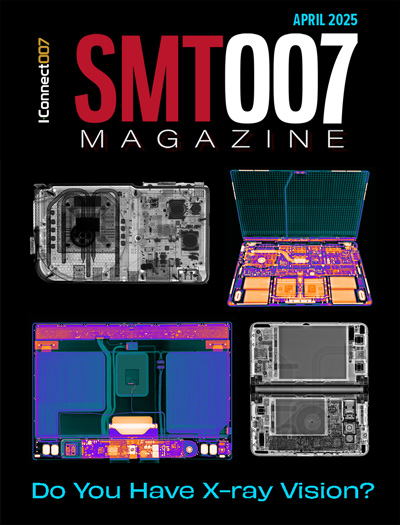-

- News
- Books
Featured Books
- smt007 Magazine
Latest Issues
Current Issue
Do You Have X-ray Vision?
Has X-ray’s time finally come in electronics manufacturing? Join us in this issue of SMT007 Magazine, where we answer this question and others to bring more efficiency to your bottom line.

IPC APEX EXPO 2025: A Preview
It’s that time again. If you’re going to Anaheim for IPC APEX EXPO 2025, we’ll see you there. In the meantime, consider this issue of SMT007 Magazine to be your golden ticket to planning the show.

Technical Resources
Key industry organizations–all with knowledge sharing as a part of their mission–share their technical repositories in this issue of SMT007 Magazine. Where can you find information critical to your work? Odds are, right here.
- Articles
- Columns
Search Console
- Links
- Media kit
||| MENU - smt007 Magazine
Driven by Technology and Subject to US Tariffs, Global PCB Market is Expected to Grow by 5.5% in 2025
April 7, 2025 | TPCAEstimated reading time: 5 minutes
In 2024, the global PCB industry will demonstrate technology-driven and diversified development. AI servers and electric vehicle applications will become the main growth drivers.
The mobile phone and memory markets will gradually recover, driving a recovery in overall demand. Among them, HDI and HLC benefited from the growth of the AI server market and specification upgrades, and performed particularly well. According to preliminary statistics, the global PCB output value will grow by about 7.6% in 2024 to reach US$80.9 billion.
Looking ahead to 2025, the demand for AI servers and electric vehicles will continue to drive industry development. The global PCB market is expected to grow by 5.5%, with an output value of US$85.4 billion, and the market will develop steadily upward.
Regarding the development of the global PCB industry in 2025, the Taiwan Printed Circuit Association (TPCA) and the Industrial Technology Research Institute (ISTI) have sorted out three important key issues:
1. AI will gradually penetrate from the cloud to edge computing, and electronic products will once again undergo large-scale changes.
AI will gradually penetrate from the cloud to edge computing (Edge AI), which will set off a new wave of electronic product upgrades after 5G.
With the enhancement of data processing, machine learning and automation technologies, the demand for key components such as semiconductors, packaging and PCBs will increase simultaneously. In particular, functional innovations in smartphones, computers and wearable devices are expected to drive sales to rebound. Compared with the large language model (LLM) used in cloud AI, Edge AI's key technology sLLM (miniaturized large language model) has the advantages of lightweight, low inference cost and high elasticity. It is more suitable for applications with high requirements on cost and immediacy, and will further enhance the user experience. In 2025, Edge AI will become the focus of the market, and the advancement of emerging technologies such as DeepSeek will also accelerate the launch of new products and boost demand for high-end equipment, bringing more opportunities for the PCB and electronic components industry to enter the mid-to-high-end market.
2. EMS factories start Made in America, and the global trade pattern may change.
With Trump's re-election, in order to reduce the United States' dependence on overseas goods and improve the trade deficit, the US government plans to impose a 10-20% tariff on imported products, and even increase some goods to 60%. The "Made in America" policy is reshaping the electronics industry supply chain. In the past, most EMS factories moved to emerging markets such as Southeast Asia, India and Mexico. It is estimated that after 2025, the United States will become another important production base. Although the current production capacity in the United States remains to be seen, this trend will reshape the trade structure of the upstream industry and force the supply chain to adjust its export strategy to adapt to the market changes brought about by the US manufacturing policy. Whether it will affect the export and capacity allocation of the upstream PCB industry in the future remains to be seen.
In addition, TSMC also announced in early March that it would expand its investment in the United States by US$100 billion, which shows that the impact of the US government's series of tariff policies and high-end technology controls on Taiwanese companies has already fermented.
Currently, the global PCB production capacity is mainly concentrated in mainland China, which is the country affected by the first wave of tariffs. Industrial diversion will become the main response strategy. Although Thailand, as an emerging PCB production center, has not been included in the tariff list, it still poses risks. Companies must adjust production locations in advance, increase product added value, and expand new markets to reduce the impact of changes in trade policies.
At the TPCA Member Conference Benchmark Forum, which just ended in mid-March, TPCA also held a forum titled "The Impact of Trump 2.0 on PCBs and Countermeasures". Speakers at the meeting analyzed the new international situation brought about by "Trump 2.0" from multiple levels, including policies, industries, and corporate governance, and provided the industry with many directions for thinking, such as supply chain layout and restructuring, expanding opportunities for cooperation in other regions, adjusting investment strategies for tariff-derived industries, industrial changes in ASEAN and India, policies and regulations of host countries/importing countries/exporting countries, and the impact of US policies on ESG. These are all important issues that the industry must continue to pay attention to in the international political situation.
3. Thailand's PCB cluster faces a talent shortage, and mass production progress may be affected.
Since 2023, Taiwan and mainland China PCB companies have accelerated their layout in Thailand. By the end of 2024, more than 30 manufacturers have entered Thailand and plan to start mass production in 2025. However, as Thailand's PCB production capacity is expanded, local labor supply may become the biggest challenge in the short term.
Thailand's local labor force is limited and cannot support the rapid expansion of the PCB industry. Thai factories must rely on neighboring countries such as Myanmar and Laos for additional manpower, and must increase wages and benefits, which will further increase operating costs. To address the talent shortage, companies should establish a diverse local talent pipeline, cultivate technical talent through local industry-university collaboration, and enhance automated production capabilities to ensure the smooth implementation of mass production plans. To this end, TPCA also launched the PCB International Talent Training Program last year, and has started the first phase of training and job matching with three colleges and universities in Thailand, and continues to promote PCB talent training in Thailand. In August this year, it plans to integrate enterprises, schools and Thai official resources to establish a PCB Academy platform to help the industry overcome the talent shortage.
Looking ahead to 2025, the global PCB market is expected to maintain steady growth driven by demand for AI servers and electric vehicles. However, industrial development is still affected by technological changes and international trade policies, and the supply chain layout needs to be more flexible and responsive. Overall, PCB manufacturers need to strengthen high-end technology research and development, optimize supply chain management, and flexibly adjust market strategies to ensure steady growth amid global industrial changes.
Suggested Items
ASMC 2025 Showcases AI and Emerging Technologies Shaping the Future of Semiconductor Manufacturing
04/15/2025 | SEMIThe 36th annual Advanced Semiconductor Manufacturing Conference (ASMC) 2025 will be held May 5-8, 2025, in Albany, New York, bringing together leaders in semiconductor manufacturing to explore cutting-edge advancements driving high-volume production and AI-powered innovation.
MVTec HALCON Version Includes Deep Learning-Based Technology for Robust Bin Picking
04/15/2025 | MVTecMVTec Software GmbH, a leading global manufacturer of machine vision software, is launching the new version of MVTec HALCON on May 27, 2025. Version 25.05 of the standard machine vision software includes numerous improvements as well as a new technology that combines deep learning algorithms with classic methods.
IPC President’s Award: Dr. Thomas Marktscheffel
04/15/2025 | Nolan Johnson, I-Connect007At ASMPT SMT Solutions, Thomas Marktscheffel, director of product management software solutions, is responsible for the SMT line software portfolio. As a member and leader of several IPC committees, he is also a driving force for global industry standards such as IPC-2591 CFX and IPC-HERMES-9852, which make it possible to provide plug-and-play connectivity for intelligent SMT Factories. In 2015, he participated in the IPC-1782 A-team and subsequently joined the IPC-2591 CFX standard A-team, which became the new SMT industry communication standard following its first release in March 2019.
BEST Inc to Host Soldering 101 Workshop at Illinois & Michigan Locations
04/15/2025 | BEST Inc.BEST Inc., a leader in electronic component services, training, and products is pleased to announce it will host multiple Soldering 101 workshops in its Rolling Meadows, Illinois and Lansing, Michigan locations.
Electronic System Design Industry Posts $4.9 Billion in Revenue in Q4 2024
04/15/2025 | SEMIElectronic System Design (ESD) industry revenue increased 11% to $4,927.3 million in the fourth quarter of 2024 from the $4440.9 million reported in the fourth quarter of 2023, the ESD Alliance, a SEMI Technology Community, announced in its latest Electronic Design Market Data (EDMD) report.


